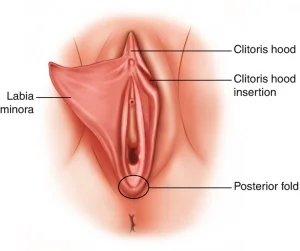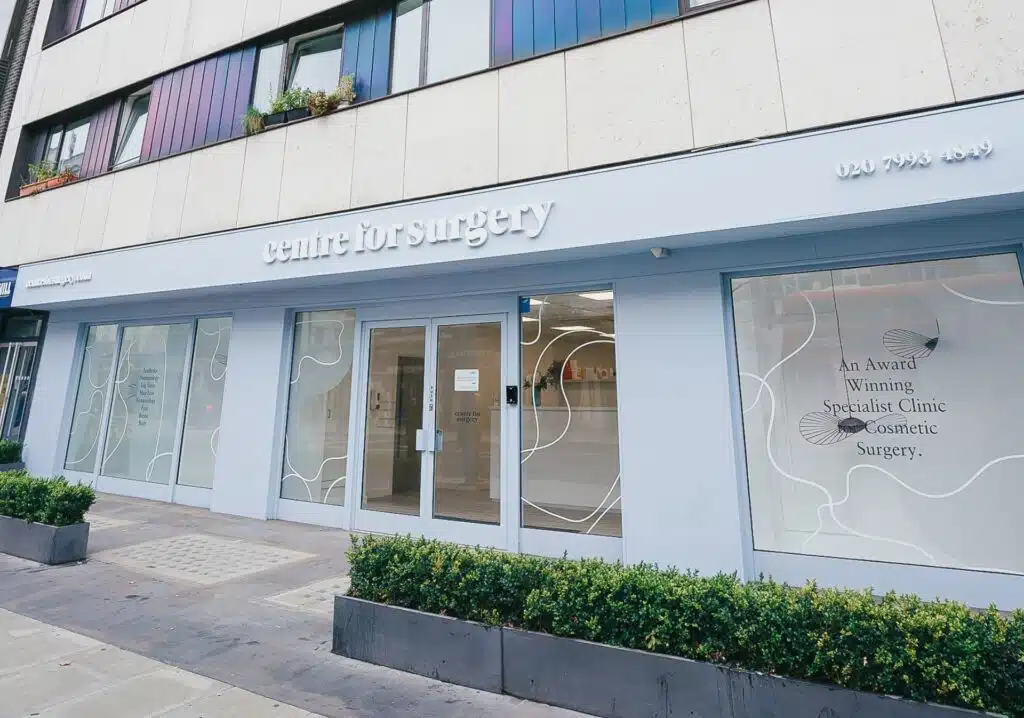The physical appearance of the labia varies enormously from one woman to the other, just as people differ in their skin colour or facial characteristics. It is a common misconception that normal labia conform to one particular type of appearance. However, many women may wish to alter the size and shape of the labia either because of discomfort or because they are simply unhappy with their appearance. Labial hypertrophy affects many women in the UK.
What is Labial Hypertrophy?
Labial hypertrophy is used to describe the common condition of enlarged labia, also known as vaginal lips. In many cases, there may be a significant degree of labia asymmetry. Although no woman has perfect labia symmetry, when one labium is more prominent than the other side, it is often highly visible and can result in a loss of self-confidence. This type of labial hypertrophy is harmless because it is not related to an underlying serious medical condition.
RELATED: What is a Labiaplasty?
Causes of labial hypertrophy
Enlarged or hypertrophied labia can be caused by a number of potential causes. In most cases, there may be no underlying cause. Just as the breasts significantly change in size and shape over the course of a woman’s life, the change in size and shape of the labia can similarly change in response to hormonal fluctuations and the natural ageing process.
RELATED: Understanding When Labiaplasty Can Provide Relief from Discomfort
Many women may develop large labia with age. As oestrogen levels decrease, the labial tissue may lengthen, particularly as women approach menopause. This is a similar mechanism causing labial hypertrophy during puberty. Changes in the levels of oestrogen can result in several biological changes, and the growth of the labia is one example of this. Labial hypertrophy can also be caused by pregnancy. The mechanism causing large labia in this situation is often due to increased blood flow to the vaginal area and this can result in engorgement of the vaginal tissues, and the area can often feel heavy.
Many cases of labial hypertrophy are related to genetics. Women may often find that their first-degree relatives have also experienced labial enlargement, which has been present from birth. In those with a genetic predisposition to labial hypertrophy, it is possible to see enlarged labia before puberty develops.
Symptoms of labial hypertrophy
The aesthetics of the labia is something very personalised to the individual patient and a wide range of symptoms may prompt women to seek medical attention. Having said that, most cases of labial hypertrophy that result in symptoms can be easily confirmed by a visual examination of the labia. Labial hypertrophy can result in a loss of confidence with the inability to form intimate relationships with a resultant reduction in emotional well-being for many affected women.
Enlarged labia may occur on one or both sides, and labial hypertrophy can affect the labia minora and the labia majora. These outer lips sit on either side of the labia minora. Labial hypertrophy is commonly referred to the enlargement of the labia minora or the inner lips. Women with big labia often have thickened labial tissue with a stretched appearance. This can result in the enlarged labia bulging through common clothing items, including swimwear.
Besides cosmetic considerations, labial hypertrophy can result in significant discomfort from repeated irritation of the labia minora. Women often describe tenderness and sensitivity when the labia minora are touched, as the inner lips contain more nerve endings than the labia majora. Enlarged labia can rub on clothing, resulting in continual friction and, eventually, sensitivity. Women may develop discomfort during sexual intercourse due to large labia exerting undue pressure on the genitalia. This problem can also occur during physical exercise.
The presence of enlarged labial tissue and extra folds of skin may result in some women developing problems with hygiene. Labial hypertrophy is linked with an increased incidence of bacterial and fungal infections.
Labial hypertrophy treatment
It is important to bear in mind that the aesthetics of the labia minora is highly subjective. What is normal in one woman may be considered unsightly in another. No specific diagnostic tests can be performed to confirm labial hypertrophy. There is no official system of measurement to confirm the degree of hypertrophied labia. Every woman is different, and there will always be a degree of asymmetry that can be considered a normal variant if this is barely noticeable.
Labial hypertrophy is not detrimental to overall health and well-being. However, many women will wish to have treatment to alleviate functional symptoms of pain and irritation or for cosmetic improvement. Labial hypertrophy is diagnosed after a physical examination by an expert gynaecologist. Our surgeons treat many women each year suffering from labial hypertrophy with surgery to alter the size and shape of the labia.
Labiaplasty, which is also known as labia reduction, is suitable for women who consider their labia minora to be too big or uneven. A labia minora that is too large can cause discomfort during certain activities or while wearing certain clothing. There is a range of causes for a large labia minora. This includes hormonal changes, childbirth, ageing or simply the shape when you were born.
Anatomy of the female genitalia
Labia minora – these are the inner lips that are made up of 2 folds of tissue that extend backwards on each side of the vaginal opening (introitus). The labia minora can vary in the degree of pigmentation and are typically hairless.
Labia majora – these are the outer lips of tissue that extend backwards from the mons pubis. The labia majora contains hair, and its appearance can vary from full to looser and baggy appearance. Labia majora reduction can tighten the labia majora by surgically removing loose skin.
Clitoris – The clitoris is oval-shaped and is an erectile mass of tissue located beneath the urethral opening and is connected to the mons pubis. It contains many sensory nerve endings. A hoodectomy can reduce the size of the clitoral hood.
Mons pubis – the defined adipose tissue area in a triangular shape above the labia and covered by pubic hair. The size of the mons pubis can be reduced with a mons lift.
There is considerable variation in the appearance of the female genitalia. However, most women who request a labiaplasty procedure typically have a very specific shape in which the labia minora or labia majora are overly prominent, whether in the front, middle or back part. It is not uncommon for there to be a considerable amount of asymmetry between left and right labia minora and this can also be corrected with a labiaplasty procedure.
Knowledge of the anatomy of the external genitalia is helpful for gaining a better appreciation of the different labiaplasty techniques.

Asymmetries can also exist in other areas such as the clitoral hood, thickness of labia minora or pigmentation.
Labiaplasty focuses on reducing, reshaping and contouring the labia minora and/or labia majora so you will no longer feel any physical discomfort. A clitoral hood reduction can also be performed if symptoms are experienced from too much tissue or asymmetry in this area to effectively balance the appearance.
The labiaplasty consultation
At your consultation, you will undergo a full medical assessment. A medical history will be taken, and a thorough physical examination will be carried out. The vaginal rejuvenation technique will be fully explained. You will be able to express any concerns and have your questions about the procedure answered. A customised treatment will then be prepared for you.
If you wish, your surgeon may be able to show you a selection of before-and-after photographs of previous patients to show you what can be achieved with labia reduction surgery.
The best way to treat labial hypertrophy is with labiaplasty. Labiaplasty surgery involves the removal of excess labial tissue to achieve a desired cosmetic appearance. There are two different types of labiaplasty procedures. The first is the trim labiaplasty technique, which involves surgically making a linear incision to reduce the size of the enlarged labia. This technique is particularly useful for removing labial edges that appear excessively pigmented. The desired result is smaller-sized labia that have a more uniform colour and an enhanced shape.
RELATED: Trim Labiaplasty vs Wedge Labiaplasty
The second technique for a labiaplasty is a wedge labiaplasty. This technique involves removing tissue by making a triangular-shaped cut in the central part of the labia. The incision results in two edges that will be stitched together to produce a smaller-sized labia. This type of labiaplasty often produces an excellent transition from the clitoral hood area without causing any potential irregularities in the labial edges.
The type of labiaplasty chosen to treat labial hypertrophy will depend on the tissue characteristics of the labia as well as your individual needs and preferences. Our surgeons have over ten years of experience helping women in London and surrounding areas. We are home to female gynaecologists experienced in treating all types of labial hypertrophy with labiaplasty surgery. If you would like to learn more about treatment for labial hypertrophy and the cost of labiaplasty, please contact us today and speak to one of our friendly and knowledgeable patient coordinators at 020 7993 4849.










